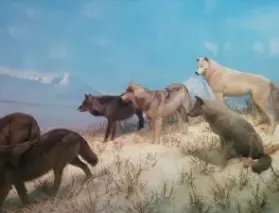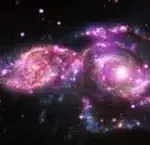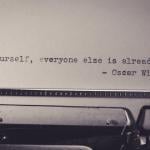Last week Thomas Schenk wrote an excellent article on the sacred. This week Daniel Strain adds some more thoughts on this topic…

I’m walking in the woods on a brisk, sunny morning. The golden light shines through the branches, splitting beams of light in a slight morning mist. Reddish leaves crunch beneath my feet in early fall. I take each step slowly, deliberately. Looking all around, trying to take in every detail; every insect, every quiver of a tree in the slow gentle breeze. I can hear the sounds of the forest around me, but only if I listen carefully. It is easy here to have a sense of the sacred. I live in the city and environments like this are not something I see everyday, even though I enjoy the trees in my yard.
I stop by Rothko Chapel in Houston, Texas to meditate for a bit. Before getting out of the car, I put my phone on silent and leave it in the glove compartment. I am about to set foot on sacred ground and have a personal rule about leaving electronics behind. Walking up to the building I try to keep my mind clear and focused. As I pass the obelisk I observe its reflection in the still water before entering the silent interior. I sit among the tall black void paintings surrounding me in pure silence and train all of my focus on the breath.
Sometimes it is easy to have a sense of the sacred. Sometimes we choose it; sometimes it falls upon us unexpectedly. Rationally, I know these places and events are devoid of inherent meaning. They are all the same: the chapel, the woods, the grocery store, the mall, the movie theater, the courthouse, the office, the dump, the moon of Europa. They are all the same here, at the base of understanding.
Sacred comes from Latin roots that mean ‘dedicated’ or ‘set apart’. Namely, those things set apart for veneration or to be revered. Why would a Spiritual Naturalist see reason to set times, places, things, or events apart for veneration or reverence?
Our practice is one of moving toward greater flourishing – a deep happiness or contentment in life that is stronger than our circumstances, but helps us to live the good life and be good actors in the world. In terms of basic human nature (psychology), a sense of the sacred is healthy and promotes our well-being.
It can be a source of expression and sharing of experience. A sense of the sacred can be a tool for keeping perspective and balance in our lives and values. It can be a source of inspiration, appreciation, and strength. A sense of the sacred is a way to invite love, beauty, and meaning into our lives. We don’t need to discover meaning – we are the universe’s meaning-makers.
Before any outward ritual acts or movements of the body, we observe sacred moments or places first within. In the deepest core of our intention, we clear our minds as one clears the table for a feast. We center ourselves and bring attention to the meaning, the impact, the significance of the moment or place. Rituals and acts can grow from that inward state of sacredness. Things like leaving behind electronics or other distractions, breathing in special ways, movements such as bowing, and so on. These vary by tradition, custom, and most importantly, by what is personally meaningful and transformative to the practitioner.
In addition, we center onto certain aspects of ourselves. In a Zenlike space, we seek to think, act, and speak from our higher more aware and conscious dispositions, rather than quick, impulsive, impatient, petty, ego-based, intolerant, or judgmental aspects. In a more ecstatic environment, we may bring our instinctive, feeling, intuitive elements to the front, allowing ourselves to flow or be lost in the moment without self-consciousness. Each of these has a role and a value in practice. This is how we reaffirm our value systems, experience them intuitively, and help to attune mental pathways consistently with them such that epiphany, harmony, and understanding ensue. This kind of talk can be frustratingly vague or overly poetic for some, but the answers become clearer with experience of sacred practices.
The question may arise, what should be considered sacred? “Spiritual Naturalists revere Nature” might be a straightforward, though, overly simple summary – perhaps even misleading.
Nature needn’t simply mean “trees and rocks, etc.” By Nature we also mean the natural universe, the cosmos – the root of all being. Some terms like the Logos, or the Tao have been used in a similar way; in other words, ultimate Reality. For the naturalist, the universe is One integrated whole. There is no cause for suspicion or particular thoughts of a super-nature. This Oneness or wholeness to the world is integral to interconnectedness, interdependence, and natural law.
French sociologist Émile Durkheim posited a dichotomy of the ‘sacred and profane‘ as the central characteristic of all religion. He defined the profane as the ‘natural world of the senses’. This leaves all Spiritual and Religious Naturalists out in the cold, so to speak. Therefore, we do not find any meaning or use in this dichotomy or categorization, and instead employ a more suitable measure.
This question has many answers which can subtly overlap with simultaneous truth, depending on the particulars and the practitioner. But one approach is to consider those things most fundamental to the aim of our practice – flourishing.
Here we have a spectrum ranging from the most foundational, upward. At the most foundational level would be natural law, but seen with a more sacred flavor. The Stoics spoke of the Logos – the order by which all things happened. This is somewhat equivalent to the Tao, or “The Way of Things”. This sacred tongue framing of the root order of Nature is an essential part of having a sense of the sacred, and in the kind of framing that helps to set perspectives, dispositions, and the values that make flourishing possible.
Further up the ladder would be aspects of the cosmos that derive from the Logos, such as impermanence, interdependence, complexity, emergence, and more. Coming into psychological harmony with these fundamental aspects of Nature helps to prepare us for the flow of life and what it brings. They eventually manifest in tertiary aspects of the cosmos, all the way up to sacred moments like the birth of a child, a marriage, and so on.
These are not the way you would categorize the traits of the cosmos as a physicist or cosmologist, but they are ways of categorizing the cosmos that is helpful to happy, wise, and skillful living for a human. I therefore like to refer to this approach as a “spiritual taxonomy of the cosmos”.
Our cat, Tigger, lies on my chest purring. He likes his head to be held and warmed. His whiskers are fine and elegant. He is so happy, and I wonder what his inner experience is like. I imagine, that if all of the cosmos was born, the stars cooked the heavier elements, the planets arose, life evolved, all so a being like him and me could share this moment, it would have been worth it.
Appreciation of these kinds of traits of Nature not only helps us to come to expect things like loss or change, but we can eventually come to see a dynamic beauty to this fractal tapestry of Nature. Seeing it as beautiful is key to building a relationship with the cosmos, which is how we begin to walk with a sense of the sacred. This is where values move from prescriptive codes to inner character and consciousness and true wisdom arises.
But much earlier than this, everyone can begin to approach the world with a sense of the sacred. In many ways, it is the loss of this sense that has caused many problems today. Even within traditional religions, there has been a loss of the sacred as they have become more like political or economic bodies than spiritual communities.
For example, perhaps more of a sense of the sacred in those who serve in government would help address many problems. Perhaps the same for those in business. And what would happen to the culture within a police department if trainers and officers began to talk more openly and seriously about the sacredness of their role and mission in society? Perhaps a ‘bottom up’ rebirth of virtue would be more effective than a ‘top down’ system of punishments and rewards.
My wife and I are at the beach. It’s too cold to be at the beach, but we go anyway. The birds are feeding, the shelled creatures crawling. The smell of salt water is in the air and we remove our shoes. Stepping into the water in new places has been something we’ve often made a point to do. We want to “commune with the ocean womb of life”. This was going to church for us.
If sacred means ‘setting apart for reverence’, asking what is sacred begs the question of who it is that is doing the ‘setting apart’ and ‘revering’. Because all practitioners are different, and each becoming more aware in their own way and time, sacredness is a shifting, overlapping, and nested organism. Ultimately, as we are transformed through practice toward greater awareness, compassion, and wisdom, we begin to see the sacred in more and more places. Every step is as on sacred ground. It reveals itself at unexpected times. Its “beauty in the moonlight” overthrows us[1]. We come full circle and once again they are all the same: “Holy the jazzbands marijuana hipsters peace peyote pipes & drums!” – yes, even holy the “Angel in Moloch”[2]. They are all the same here, at the pinnacle of understanding.
I sit in the hospital holding my father’s hand as the machines monitor his vital signs. It is old, bruised, and cold. I think about the hand I often held as a child. He would not be with us much longer. I’m reminded of sitting in the same position with my mother’s hand a decade earlier. He lived a long life and was surrounded by a loving family. Today is still hard for everyone. Birth and Death are sacred moments. They are because they have to be.
Learn about Membership in the Spiritual Naturalist Society
__________
The Spiritual Naturalist Society works to spread awareness of spiritual naturalism as a way of life, develop its thought and practice, and help bring together like-minded practitioners in fellowship.
Notes
- “Hallelujah” by Leonard Cohen
- “Howl” by Allen Ginsberg












